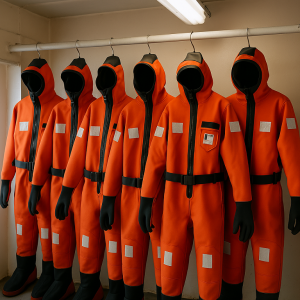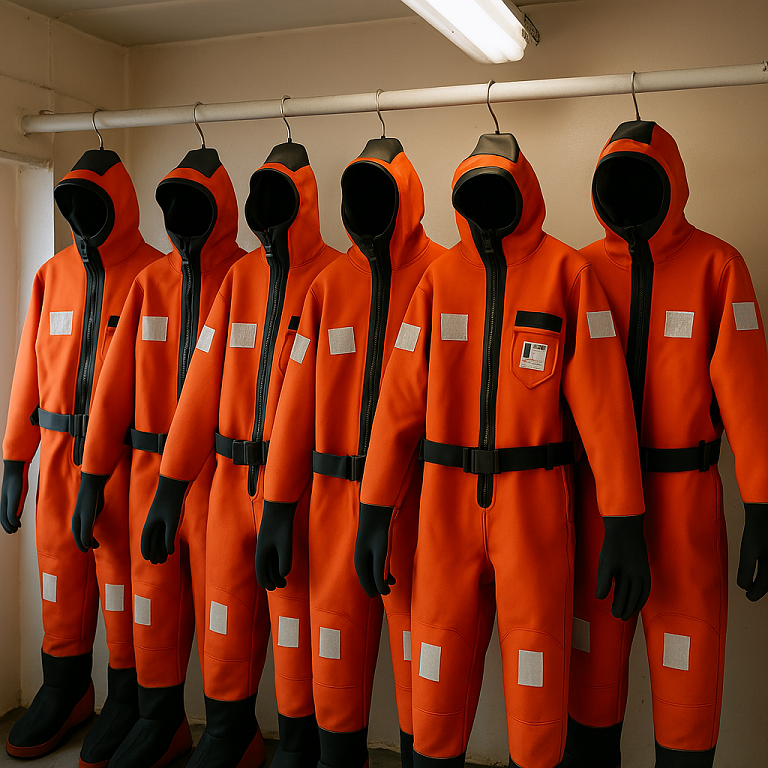Immersion suits are vital safety gear for seafarers, designed to provide protection against hypothermia and other dangers associated with cold water immersion. These suits are essential in emergencies, offering a lifeline to individuals who may find themselves in perilous situations at sea. This article explores the design, usage, and maintenance of immersion suits, emphasizing their crucial role in enhancing seafarer safety during emergencies.
Understanding Immersion Suits
Immersion suits, also known as survival suits, are specialized garments intended to protect individuals from the life-threatening hazards of exposure to cold water. They have become standard safety equipment on ships, particularly in regions prone to harsh maritime conditions. The primary function of an immersion suit is to provide thermal insulation and buoyancy, helping to maintain body temperature and keep the wearer afloat until rescue. According to the International Convention for the Safety of Life at Sea (SOLAS), all commercial vessels operating in cold water must carry immersion suits for each crew member. These regulations underscore the importance of immersion suits as a critical component of maritime safety.

Design Features of Immersion Suits
Immersion suits are engineered with several key features that enhance their effectiveness in emergency situations:
- Material Composition: Most immersion suits are made from neoprene or other waterproof synthetic materials that provide insulation against cold water. The suit’s design often includes multiple layers to trap body heat and minimize heat loss.
- Buoyancy: Many immersion suits come equipped with built-in buoyancy aids, which help keep the wearer afloat without requiring active swimming. This feature is crucial for survival in rough seas or when the individual is unconscious or incapacitated.
- Visibility: Immersion suits are typically bright orange or yellow, making them easily visible in the water. Reflective strips may also be included to enhance visibility during rescue operations.
- Ease of Donning: In emergencies, time is of the essence. Most immersion suits are designed for quick donning, allowing users to put them on within two minutes or less. Features such as oversized zippers and adjustable straps facilitate rapid dressing.
- Integrated Accessories: Many modern immersion suits include additional features such as hoods, gloves, and built-in whistles for signaling rescuers. Some models also have buddy lines that allow survivors to connect with one another in the water, enhancing group stability and visibility.
Types of Immersion Suits
There are primarily two types of immersion suits used onboard ships:
- Abandonment Immersion Suits: These are designed for emergency situations where crew members must abandon ship quickly. They offer thermal protection and buoyancy but are not intended for prolonged use in cold environments.
- Work Immersion Suits: These suits are used by personnel working in cold-water environments for extended periods. They provide thermal insulation and protection against splashes and harsh weather conditions but may not have the same buoyancy features as abandonment suits.
Usage Protocols for Immersion Suits
Proper training and understanding of how to use immersion suits can significantly impact survival rates during emergencies. Here are key protocols for effective use:
- Pre-Deployment Checks: Before embarking on a voyage, crew members should inspect their immersion suits for any signs of wear or damage. This includes checking zippers, seals, and buoyancy aids.
- Training Drills: Regular training drills should be conducted to familiarize crew members with donning procedures and emergency protocols involving immersion suits. Crew members should practice putting on their suits quickly and efficiently.
- Emergency Procedures: In the event of an emergency, crew members should follow established evacuation procedures while ensuring they don their immersion suits before abandoning ship or entering the water.
- Buddy System: When possible, crew members should use a buddy system during evacuations to ensure that no one is left behind and that assistance is available if needed.
Maintenance of Immersion Suits
To ensure that immersion suits remain effective and ready for use when needed, proper maintenance is essential:
- Regular Inspections: Crew members should conduct regular inspections of immersion suits at least once a month. This includes checking for tears, leaks, or any signs of degradation in materials.
- Cleaning Procedures: After each use—especially if exposed to saltwater—immersion suits should be rinsed with fresh water to remove salt and contaminants that could degrade materials over time.
- Storage Conditions: Immersion suits should be stored in a cool, dry place away from direct sunlight or extreme temperatures that could damage them. Proper storage helps prolong the life of the suit and ensures it remains ready for emergencies.
- Certification Checks: Regular certification checks should be conducted to ensure compliance with SOLAS and other relevant maritime safety regulations. This includes verifying that all components meet safety standards.
Case Studies Highlighting Effectiveness
Several incidents illustrate the importance of immersion suits in enhancing survival rates during maritime emergencies:
- MV Estonia Disaster (1994): During this tragic incident where a ferry sank in the Baltic Sea, many passengers who donned their immersion suits were able to survive until rescue teams arrived despite facing freezing temperatures in the water.
- Fishing Vessel Capsizing (2008): A fishing vessel capsized off the coast of Alaska during a storm. Crew members who had access to properly maintained immersion suits were able to stay afloat until rescued by nearby vessels, highlighting the effectiveness of these life-saving garments.
These examples demonstrate how well-designed and maintained immersion suits can significantly increase survival chances during critical incidents at sea.
✅ Frequently Asked Questions (FAQs)
1. How long can a person survive in cold water with an immersion suit?
Immersion suits can extend survival time in freezing waters up to several hours—depending on water temperature, suit quality, and physical condition. In some cases, survival has been recorded for more than 6 hours in water below 5°C thanks to high-quality suits.
2. Are immersion suits mandatory on all ships?
Yes. As per SOLAS Chapter III, immersion suits are mandatory on all cargo ships operating in cold climates. Each crew member must have immediate access to a suit, and additional suits must be available on the bridge and engine control room.
3. Can immersion suits be reused after use?
Yes, but only after thorough cleaning, drying, and inspection. Any damage must be repaired according to the manufacturer’s instructions. If compromised, the suit should be replaced immediately.
4. What is the difference between an immersion suit and a dry suit?
While both provide water protection, immersion suits are for emergency survival, offering thermal insulation and buoyancy. Dry suits, on the other hand, are for extended use in water activities and may not have built-in buoyancy or thermal layers.
5. How often should immersion suits be pressure tested?
According to IMO Guidelines, suits should be pressure-tested every 3 years unless otherwise required by the manufacturer or flag state.
References
-
International Maritime Organization (IMO) – SOLAS Convention
-
United States Coast Guard – Immersion Suits Testing & Maintenance
-
Transport Canada Marine Safety – TP 14475: Guidelines for Immersion Suits
Related Articles on MaritimEducation.com
Final Words
As cold water remains one of the greatest threats to survival at sea, immersion suits are not merely optional gear—they are lifesaving essentials. Through rigorous training, careful maintenance, and adherence to safety standards, these suits serve as a protective barrier between seafarers and the dangers of hypothermia, increasing the odds of survival when every second counts.
➡️ Explore more maritime survival training topics and safety protocols on MaritimEducation.com.

